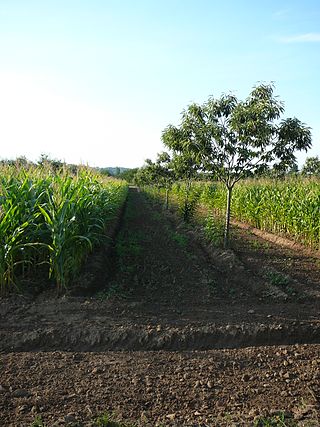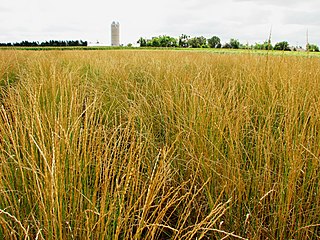
Agriculture encompasses crop and livestock production, aquaculture, fisheries, and forestry for food and non-food products. Agriculture was the key development in the rise of sedentary human civilization, whereby farming of domesticated species created food surpluses that enabled people to live in cities. While humans started gathering grains at least 105,000 years ago, nascent farmers only began planting them around 11,500 years ago. Sheep, goats, pigs, and cattle were domesticated around 10,000 years ago. Plants were independently cultivated in at least 11 regions of the world. In the 20th century, industrial agriculture based on large-scale monocultures came to dominate agricultural output.

A cereal is a grass cultivated for its edible grain. Cereals are the world's largest crops, and are therefore staple foods. They include rice, wheat, rye, oats, barley, millet, and maize. Edible grains from other plant families, such as buckwheat and quinoa are pseudocereals. Most cereals are annuals, producing one crop from each planting, though rice is sometimes grown as a perennial. Winter varieties are hardy enough to be planted in the autumn, becoming dormant in the winter, and harvested in spring or early summer; spring varieties are planted in spring and harvested in late summer. The term cereal is derived from the name of the Roman goddess of grain crops and fertility, Ceres.

Rice is a cereal grain, and in its domesticated form is the staple food for over half of the world's human population, particularly in Asia and Africa, due to the vast amount of soil that is able to grow rice. Rice is the seed of the grass species Oryza sativa or, much less commonly, O. glaberrima. Asian rice was domesticated in China some 13,500 to 8,200 years ago, while African rice was domesticated in Africa some 3,000 years ago. Rice has become commonplace in many cultures worldwide; in 2021, 787 million tons were produced, placing it fourth after sugarcane, maize, and wheat. Only some 8% of rice is traded internationally. China, India, and Indonesia are the largest consumers of rice. A substantial amount of the rice produced in developing nations is lost after harvest through factors such as poor transport and storage. Rice yields can be reduced by pests including insects, rodents, and birds, as well as by weeds, and by diseases such as rice blast. Traditional rice polycultures such as rice-duck farming, and modern integrated pest management seek to control damage from pests in a sustainable way.
The following outline is provided as an overview of and topical guide to agriculture:

Intensive agriculture, also known as intensive farming, conventional, or industrial agriculture, is a type of agriculture, both of crop plants and of animals, with higher levels of input and output per unit of agricultural land area. It is characterized by a low fallow ratio, higher use of inputs such as capital, labour, agrochemicals and water, and higher crop yields per unit land area.

Agronomy is the science and technology of producing and using plants by agriculture for food, fuel, fiber, chemicals, recreation, or land conservation. Agronomy has come to include research of plant genetics, plant physiology, meteorology, and soil science. It is the application of a combination of sciences such as biology, chemistry, economics, ecology, earth science, and genetics. Professionals of agronomy are termed agronomists.

Sustainable agriculture is farming in sustainable ways meeting society's present food and textile needs, without compromising the ability for current or future generations to meet their needs. It can be based on an understanding of ecosystem services. There are many methods to increase the sustainability of agriculture. When developing agriculture within sustainable food systems, it is important to develop flexible business process and farming practices. Agriculture has an enormous environmental footprint, playing a significant role in causing climate change, water scarcity, water pollution, land degradation, deforestation and other processes; it is simultaneously causing environmental changes and being impacted by these changes. Sustainable agriculture consists of environment friendly methods of farming that allow the production of crops or livestock without damage to human or natural systems. It involves preventing adverse effects to soil, water, biodiversity, surrounding or downstream resources—as well as to those working or living on the farm or in neighboring areas. Elements of sustainable agriculture can include permaculture, agroforestry, mixed farming, multiple cropping, and crop rotation.

In agriculture, polyculture is the practice of growing more than one crop species together in the same place at the same time, in contrast to monoculture, which had become the dominant approach in developed countries by 1950. Traditional examples include the intercropping of the Three Sisters, namely maize, beans, and squashes, by indigenous peoples of Central and North America, the rice-fish systems of Asia, and the complex mixed cropping systems of Nigeria.

The Land Institute is an American nonprofit research, education, and policy organization dedicated to sustainable agriculture, based in Salina, Kansas. Their goal is to develop an agricultural system based on perennial crops that "has the ecological stability of the prairie and a grain yield comparable to that from annual crops".

In botany, a perennial plant or simply perennial is a plant that lives more than two years. The term is often used to differentiate a plant from shorter-lived annuals and biennials. The term is also widely used to distinguish plants with little or no woody growth from trees and shrubs, which are also technically perennials. Notably, it is estimated that 94% of plant species fall under the category of perennials, underscoring the prevalence of plants with lifespans exceeding two years in the botanical world.

Agroforestry is a land use management system that integrates trees with crops or pasture. It combines agricultural and forestry technologies. As a polyculture system, an agroforestry system can produce timber and wood products, fruits, nuts, other edible plant products, edible mushrooms, medicinal plants, ornamental plants, animals and animal products, and other products from both domesticated and wild species.

Distichlis palmeri is an obligate emergent perennial rhizomatous dioecious halophytic C4 grass in the Poaceae (Gramineae) family. D. palmeri is a saltwater marsh grass endemic to the tidal marshes of the northern part of the Gulf of California and Islands section of the Sonoran Desert. D.palmeri is not drought tolerant. It does withstand surface drying between supra tidal events because roots extend downward to more than 1 meter where coastal substrata is still moist.

Energy crops are low-cost and low-maintenance crops grown solely for renewable bioenergy production. The crops are processed into solid, liquid or gaseous fuels, such as pellets, bioethanol or biogas. The fuels are burned to generate electrical power or heat.
Upland rice is a variety of rice grown on dry soil rather than flooded rice paddies.

A weed is a plant considered undesirable in a particular situation, growing where it conflicts with human preferences, needs, or goals. Plants with characteristics that make them hazardous, aesthetically unappealing, difficult to control in managed environments, or otherwise unwanted in farm land, orchards, gardens, lawns, parks, recreational spaces, residential and industrial areas, may all be considered weeds. The concept of weeds is particularly significant in agriculture, where the presence of weeds in fields used to grow crops may cause major losses in yields. Invasive species, plants introduced to an environment where their presence negatively impacts the overall functioning and biodiversity of the ecosystem, may also sometimes be considered weeds.

Thinopyrum intermedium, known commonly as intermediate wheatgrass, is a sod-forming perennial grass in the Triticeae tribe of Pooideae native to Europe and Western Asia. It is part of a group of plants commonly called wheatgrasses because of the similarity of their seed heads or ears to common wheat. However, wheatgrasses generally are perennial, while wheat is an annual. It has gained the Royal Horticultural Society's Award of Garden Merit as an ornamental.

Perennial rice are varieties of long-lived rice that are capable of regrowing season after season without reseeding; they are being developed by plant geneticists at several institutions. Although these varieties are genetically distinct and will be adapted for different climates and cropping systems, their lifespan is so different from other kinds of rice that they are collectively called perennial rice. Perennial rice—like many other perennial plants—can spread by horizontal stems below or just above the surface of the soil but they also reproduce sexually by producing flowers, pollen and seeds. As with any other grain crop, it is the seeds that are harvested and eaten by humans.
Perennial crops are a perennial plant species that are cultivated and live longer than two years without the need of being replanted each year. Naturally perennial crops include many fruit and nut crops; some herbs and vegetables also qualify as perennial. Perennial crops have been cultivated for thousands of years; their cultivation differs from the mainstream annual agriculture because regular tilling is not required and this results in decreased soil erosion and increased soil health. Some perennial plants that are not cultivated as perennial crops are tomatoes, whose vines can live for several years but often freeze and die in winters outside of temperate climates, and potatoes which can live for more than two years but are usually harvested yearly. Despite making up 94% of plants on earth, perennials take up only 13% of global cropland. In contrast, grain crops take up about 70% of global cropland and global caloric consumption and are largely annual plants.

Silphium integrifolium is a species of flowering plant in the family Asteraceae. Its common names include rosinweed, whole-leaf rosinweed, entire-leaf rosinweed, prairie rosinweed, and silflower. It is native to eastern North America, including Ontario in Canada and the eastern and central United States as far west as New Mexico.
De novo domestication is a process where new species are genetically altered to meet human needs, such as agriculture or companionship. It is performed both by farmers and scientists, and can be done through traditional selective breeding or modern biotechnological methods. Targets for de novo domestication are often species that have never been under cultivation, but may also include wild relatives of already domesticated species.


















